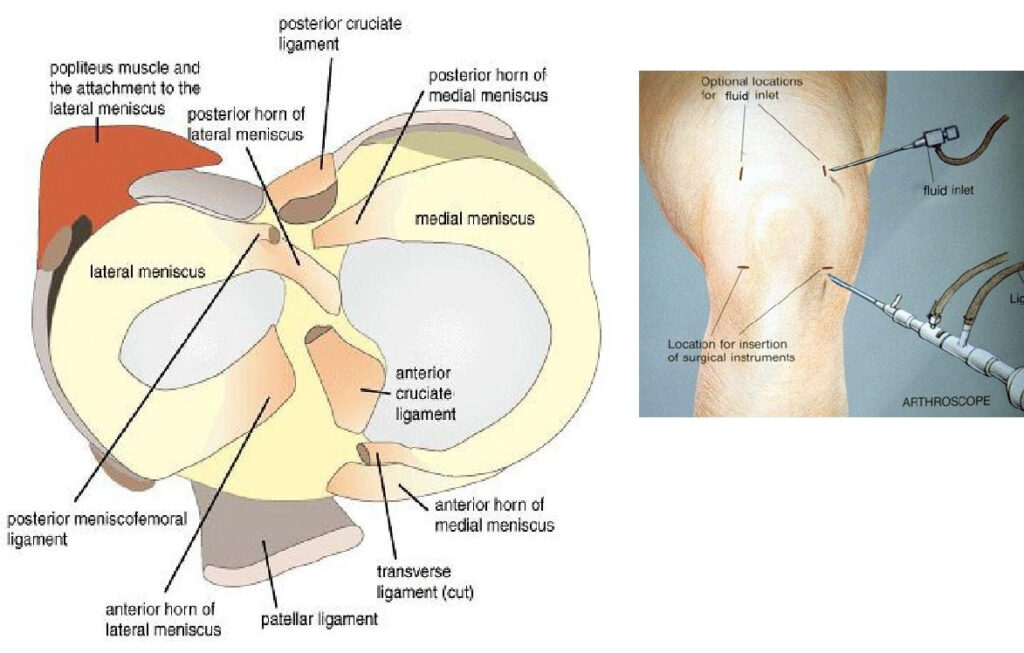- 1300 478 375
ARTHROSCOPY of the knee is an operation in which a small camera and surgical instruments are inserted into your knee through two or three small (5mm) puncture wounds. The structures within the knee are assessed including the meniscus (mobile footballer’s cartilage), the synovium (lining of the knee), the articular cartilage (joint surfaces), and the cruciate ligaments (stabilizing structures).
The most common procedures performed include removing a torn portion of a meniscus, removal of a loose fragment within the knee which causes locking or catching of the joint, tidying up of worn areas of the joint articulating surface, and release of fibrous bands which can cause restriction of movement of the joint.
Surgery is performed under a general anaesthetic and the procedure takes between 20 – 40 minutes depending on what needs to be done. Surgery is usually performed as a Day Case procedure so that you will usually be able to go home 2 – 4 hours after the operation. Sometimes, for medical reasons, you are required to stay overnight.

When you are admitted to the hospital Dr Sterling will mark the particular leg. Any last minute questions can be answered. The nursing staff and physiotherapist may also visit you to explain the procedure.
It is important to start exercising your knee as soon as possible because the muscles can become weak quite quickly. After your operation you will have a padded bandage around your knee. You cannot do any harm to your knee by lifting the leg straight, or by bending it, within the confines of the bandage. You can usually take full weight through the knee and you should try and walk as normally as possible. The exercises given to you by the physiotherapist can be started immediately. Start with a few and progress to approximately fifteen of each gradually over the next two weeks.
The bandage can be removed on the morning 2days following surgery. The puncture wounds will have a stitch or a steristrip tape keeping the wound edges together and will be covered by a small sticky dressing. Replace the dressing with an elastoplast dressing if necessary but keep the puncture wounds covered and keep the knee dry for five days to allow the puncture wounds to seal.
You will probably need to take some painkillers such as paracetamol, aspirin or ibuprofen for the first few days. This is encouraged to allow you to start exercising the knee in order to avoid developing stiffness of the joint. Wearing the tubigrip bandage and applying ice packs will help to reduce the swelling. Ice packs (or a bag of frozen peas) can be applied twice a day for ten minutes – remember to protect the skin with a towel. Your knee may be swollen for a couple of weeks or even longer after your operation. Should this occur you should avoid any strenuous activity and continue wearing the tubigrip support until the swelling has nearly gone.
Return to work when your knee feels comfortable and when you feel confident that your knee will be able to stand the stresses of your job. If you have an office type job you should be able to return to work after 1 week. If your job is strenuous and involves climbing and squatting then you will probably need two or three weeks off. PLEASE REMEMBER TO ASK FOR A CERTIFICATE IF YOU NEED ONE.
Driving is usually possible after five days when the knee is feeling comfortable. Make sure you can bend and straighten your knee vigorously without pain. Check that you can perform an emergency stop safely.
Strenuous physical activity and sport can be resumed when the knee is feeling strong and comfortable and is no longer swollen, which is usually after two to three weeks. This may depend on the type of surgery carried out. It is advisable to gradually increase your level of activity. Before returning to competitive sport such as football, squash or rugby, make sure you can hop, squat or sprint with changes of direction, and make sudden stops and starts – all without pain.
You may have moderate pain following the surgery and can take panadeine forte as provided or paracetamol The pain should lessen each day. You should contact Dr Sterling (through the switchboard of the hospital where you had your surgery), or his secretary on 1300478375. Whilst it is unlikely, if you feel extremely unwell, or there is an unexpected delay in finding Dr Sterling, attend the nearest Hospital Emergency Department.




Take the first step towards your treatment and book your initial appointment with our orthopaedic surgery team.
Prefer the phone? 1300 478 375


